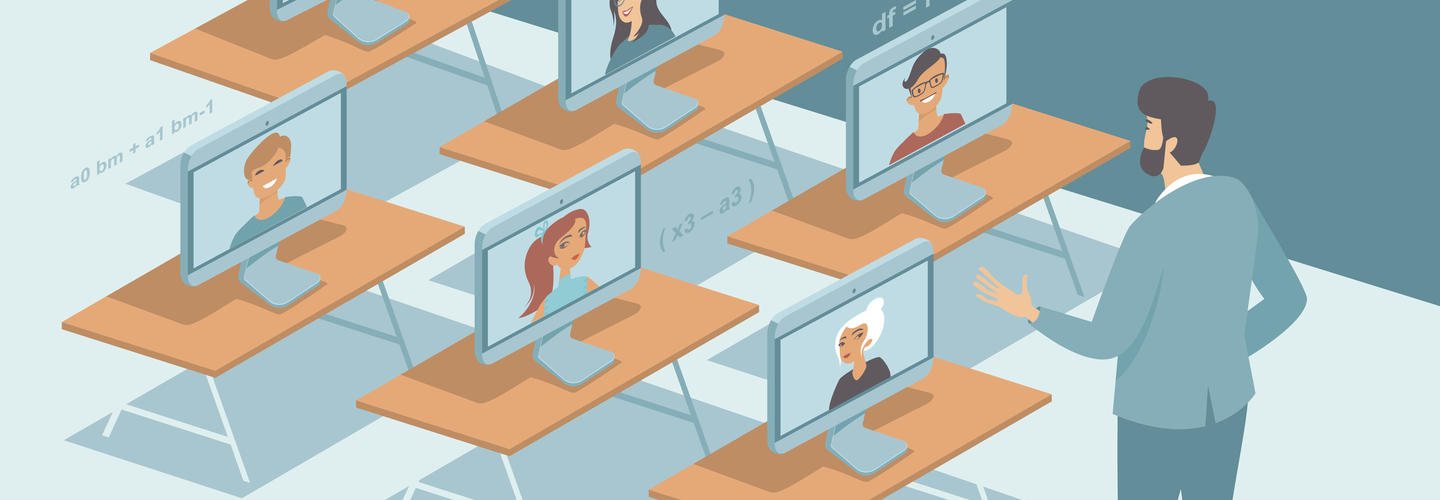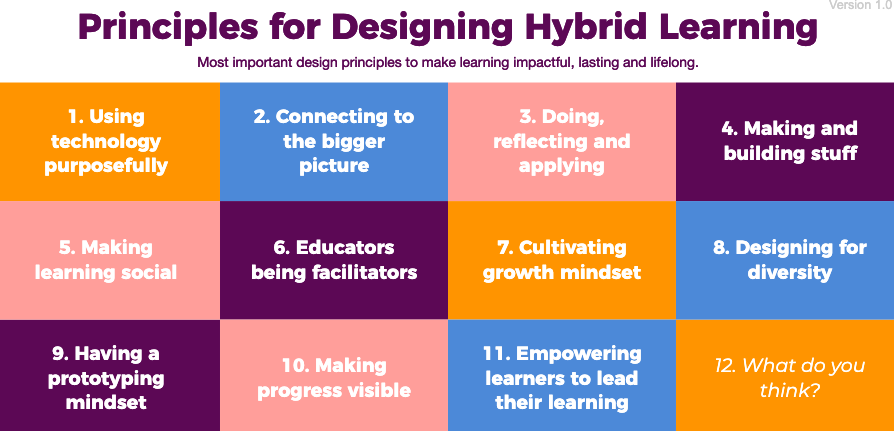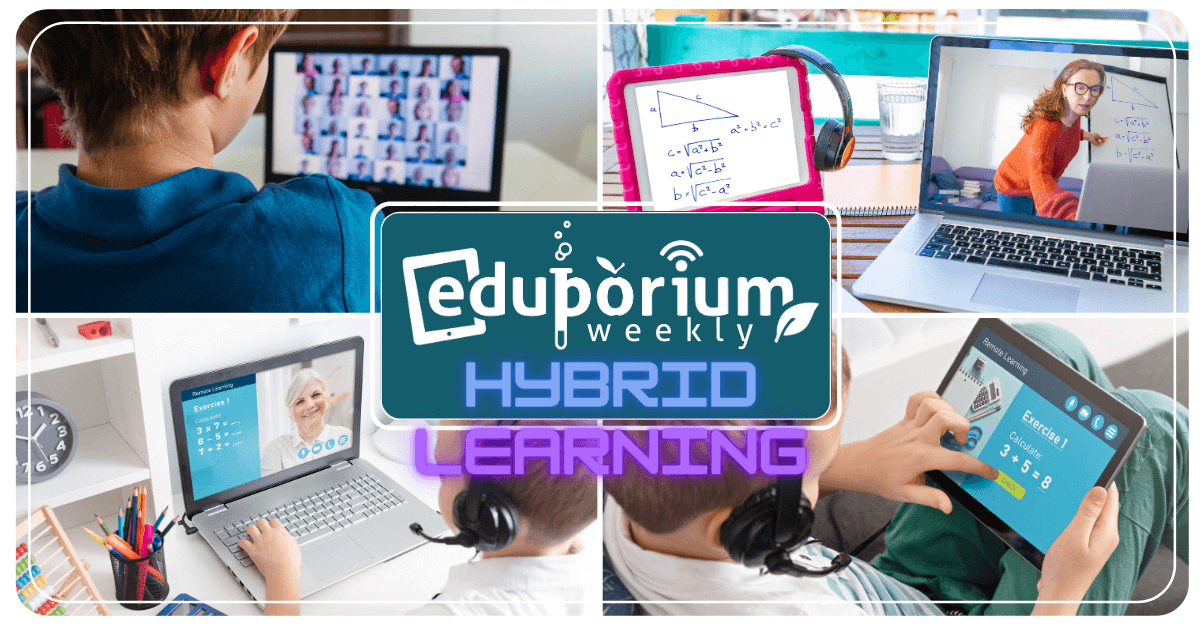As we continue to guess what education will be like this fall, it's likely that hybrid learning will be common. Despite political leaders criticizing returns as cases continue climbing, it doesn’t seem like a risk everyone wants to take. Thinking solely about educators, administrators, support staff, and bus drivers who may be compromised to communicable diseases, there's a good chance that many of them won't be comfortable with the risk. And, that’s not even mentioning the thousands of kids who live with family members who are also vulnerable. Thus, while full distance learning may not happen for everyone, it probably will happen at least some of the time. So, as we prepare for what is next, getting ready for implementing a hybrid learning model seems like it's smart.
What Is Hybrid Learning?
Since it’s been widely discussed over recent weeks, you probably have an idea of what hybrid learning is. If not, don’t worry. We're going to dive deeper into many of its details. Basically, as its name suggests, hybrid learning involves both face-to-face and remote instruction—often split up in consistent ways. Getting into a rhythm and knowing when learning will take place online as opposed to in the classroom can help teachers and kids create a more cohesive learning experience that’s a realistically viable alternative for full in-person instruction. Ideally, hybrid learning involves splitting your classroom and remote learning directly down the middle but school leaders in some places are also preparing for the possibility that this could be more like 60-40 or 75-25 depending on health factors. When implemented successfully, the two modes of teaching complement each other and help this approach work well.
For hybrid learning to be successful, a lot of planning has to take place. Educators need to consider many different factors, including their own strengths and weaknesses as well as those of the students. Strengths and weaknesses should be a fairly large focus when it comes to that remote part of hybrid learning. Ideally, children will spend at least half their time in the classroom, giving them a more normal learning experience. When then going on to discuss some of the same things and complete various assignments on topics they discussed in the classroom, it could potentially create a connection and make the remote aspect of hybrid learning feel a bit more traditional. Some educators, including those in higher education, actually advocate for hybrid learning. And, many kids tend to prefer this option and often achieve greater outcomes than with in-person or remote learning alone.
Hybrid learning provides flexibility both in terms of using instructional time and teaching lessons. Students could interact with materials in different ways as well and demonstrate what they know however works well for them. In their online portion of hybrid learning, students who prefer to learn in this way often excel. They may like the independent explorations, unique forms of collaboration, mastery-based learning, and building greater tech literacy. They can watch videos or read articles to help reinforce what they’ve been discussing and they can do so in a time and place that's most comfortable. Hybrid learning also gives them more time to complete work if they need it. Students can even become more comfortable speaking up in these virtual settings as opposed to in class. So, while it does take planning, hybrid learning actually has a lot to offer!
Hybrid Learning Elements to Consider
Though imperfect, hybrid learning might become the reality for children within a number of school systems this upcoming year. Here are key points—some that might seem fairly obvious, but still very important—for educators who'll teach like this. The first is that time should always be used wisely. It will take time for most educators to develop lesson plans, plan assessments, and provide feedback for students. This means they will have less time once the school days are done and they need to make the most of class time, especially face-to-face time. It may be critically important for some teachers and students to make the absolute most out of face-to-face meets and leave remote learning time for other, supplemental activities. This, of course, will be on a case-by-case basis, but teachers should be aware that it could happen.
With a successful hybrid model, typical classroom tasks that are possible remotely, like watching videos, reading texts, and taking notes are often best for the remote portion. For this reason, teachers could focus their in-person instruction on exploring, analyzing, and deconstructing what you talked about virtually. This can supplement remote content, ensure children have a clearer understanding, and give them time to pose any questions. In this face-to-face time, the collaboration aspect can prove super valuable as it helps both teachers and students develop new ideas and address points they may not have given thought to on their own. It’s similar to a flipped classroom model in which students consume content on their own. They then take part in some more enriched discussions once they’re all together in the classroom.
With that being said, the in-person portion of hybrid classes should remain plenty active. Children are able to review reading materials and watch the videos while at home (in most cases), so they all want to get the most value out of their time in the classroom—especially if they may feel that it’s a risk to their health being there. Teachers need to consider what students could do on their own versus what’s better to do in groups. This helps them decide how to split the tasks up between their in-person and home learning time. In either physical location, educators also need to make sure they dedicate enough time to new concepts or topics when introducing them, and then check for understanding. Asking kids if they have questions—especially on new material—will be key to making this all work.

The Student Experience in Hybrid Learning
If asked to deliver hybrid instruction, teachers will also have to consider the student experience. Educators will want their remote and in-person instruction to flow with as much synchronization as possible. So to do this, the student experience is often an important part. Especially when learning remotely, material must be engaging and students benefit from receiving it in innovative and interactive ways. And, this engagement is super important when it comes to keeping kids motivated to learn outside of classrooms. Simply assigning students to read the article at home and prepare to discuss it in their classroom, for example, isn’t going to motivate too many of them to truly apply themselves to the assignment because there’s no real excitement factor. There are, however, strategies that can make it exciting.
The first thing that teachers can do to better engage their students is create curiosity for learning about this content. Creating authentic and relevant projects can help pull children in whether they’re learning online or offline, which helps students truly buy in to their learning wherever it’s occurring. Plus, collaborative work is still possible remotely—especially if kids are in the same virtual meeting (Zoom, Google Meet, etc.). Most of these platforms offer options to record a meeting, which can benefit students. Having the ability to rewatch lessons could help them better absorb material and be valuable for collaborative, small-group work. Finally, setting clear learning goals at the beginning of all lessons, every day, or every week students are engaged in distance learning can really help them drive towards achieving something meaningful.
Students also benefit from differentiated instruction when they're learning remotely. When monitoring kids' progress, educators could choose to give them options to skip certain steps or assignments once they're proficient. This helps keep boredom at a minimum and helps them recognize when they’ve done well. On the other hand, teachers could encourage other kids to try extra work to help them catch up if necessary. The experience each student has will likely be different and, since a new school year is starting, teachers will all likely have all new students that they’re trying to get to know on the fly. Learning about their home situation (laptop availability, Internet connectivity, etc.) is important and provides valuable information for teachers to differentiate.
Differences Between Blended and Hybrid Learning
Even before the coronavirus pandemic forced school leaders all around the world to close their doors, a lot of them were creating blended learning experiences for the students they serve. Blended learning has been an educational technique for quite a while now and has really become a big part of this learning experience for some kids, including the entire learning experience for a handful of them. Online courses are, of course, more prevalent at the college level, but a blended approach works for K-12 classes, too. Blended learning isn't exactly like hybrid learning since hybrid learning is typically a 50-50 split between schools and home. That is not the goal in blended learning environments, however. Teachers seek to help children move past how they learned before technology made much more possible.
In the past, learning was largely the same for every student—sitting in class, listening to a teacher, taking notes, taking a test, and receiving a grade. Those for whom this process worked well often received good grades and were satisfied. And, those for whom it didn’t work so well for, however, might often fell behind academically. Now, as both personalization and technology each continue to play an increasing role in the education process, educational leaders are more aware than ever that a lifelong exposure to technology is changing how today’s students learn and develop—and how they want to learn. They’ve grown up around technology and like receiving information in engaging and concise ways—not drawn out in a lecture. Plus, though blended learning is also effective under normal circumstances, it can help educators with current remote learning challenges, too.
Though blended learning and what we’ve come to learn about hybrid learning may seem real similar, there are differences. In blended learning, the intent is just to combine in-person and online learning, whereas in hybrid learning, every outcome will be a combination of in-person learning and distance learning. What we are getting at is students might not necessarily be connected to the Internet for the entirety (or any) of their remote education experiences under a hybrid model. With a hybrid model, it’s more about finding the right mixture for keeping kids on track while outside the classroom. In other words, hybrid learning experiences don’t require as much of a focus on using technology as a full blended learning experience would, but, as this becomes a likely option for many kids, they might be forced to connect with teachers and classmates virtually for at least part of their home learning time.

Planning for Hybrid Classes, Instruction, and Activities
Planning is a huge element for hybrid learning—perhaps even more so than in our traditional teaching and learning environments. This starts with ensuring online assignments fit well in online learning and in-person assignments work in any classroom. Getting every experience to seem like a natural fit for the medium you deliver it in takes planning and intent. When it comes to lesson planning, the easiest route for instructors to take is simply adapting existing, in-person lessons to a way that will work for hybrid teaching whenever it is possible to do so. Setting clear goals like determining what academic concepts you want children to know, developing relevant online activities, integrating the face-to-face and online experiences, deciding on what daily schedules will look like, and more all go into the planning.
When it comes to structuring class time and activities, planning ahead can be very beneficial as well. Since there's greater flexibility in hybrid learning, how teachers choose to approach that will likely vary quite a bit. For example, different class periods don’t necessarily have to run between specific times and can fluctuate each day or week. Also, if any educators notice that a majority of children are struggling with a topic in one subject, they can dedicate more time to ensure they understand it before moving on to a new topic or new subject. They can also make time for one-on-one conversations with some kids, especially if siblings need a device at specific times.
Typically, hybrid models involve educators leading regular instruction in face-to-face sessions and students completing online assignments based on those activities. They often then post the lessons in online forums so that students and teachers can discuss them together. Educators can even place video lectures or other video resources online for kids to review on their own and then engage in discussions during their normally scheduled class time. This fall, we are anticipating seeing in-class meetings taking place for one week and then hybrid (online) learning taking place for one week (and continuing to alternate). Children can hopefully still work in groups despite physical distance between them. Or, educators may often wind up leading final discussions or assessments in person. I guess we’ll have to wait and see how it works out.
For the latest EdTech, STEM, and 21st century education news, follow us on Twitter and Instagram. Like us on Facebook, too, or sign up for our newsletter for our latest product announcements and offerings. If you have an idea for an Eduporium Weekly theme, send us a message on social media or comment below.



